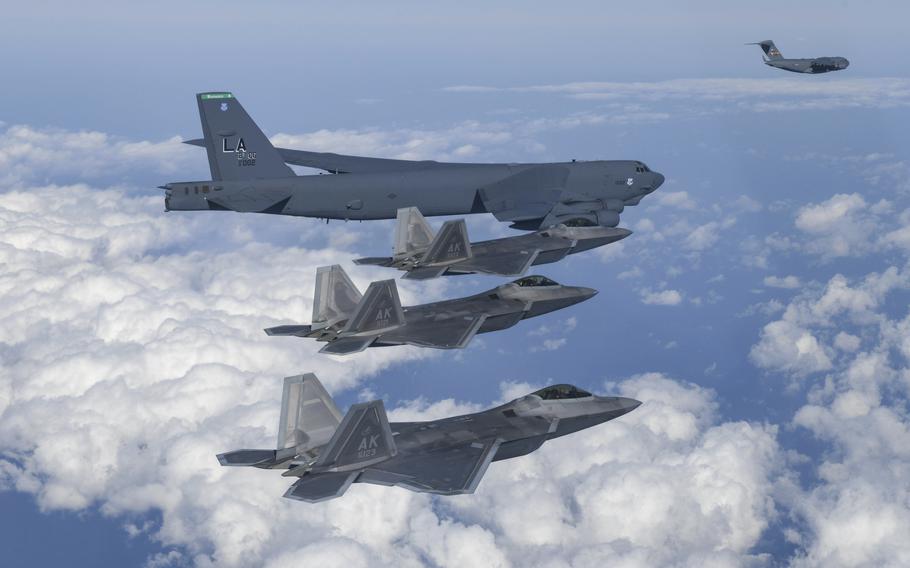
A U.S. B-52 bomber, C-17, and U.S. Air Force F-22 fighter jets fly over the Korean Peninsula during a joint air drill in South Korea on Dec. 20, 2022. The United States flew nuclear-capable B-52 bombers to the Korean Peninsula again on Wednesday, April 5, 2023, in a show of strength against North Korea amid concerns that the North might conduct a nuclear test. (South Korean Defense Ministry)
CAMP HUMPHREYS, South Korea — North Korea’s state-run news agency on Thursday condemned the United States and South Korea for their largest-ever joint military drills and warned that they raised regional tensions to an “extremely critical phase.”
The “unprecedented” military drills last month targeted Pyongyang, which will respond “through offensive action,” according to a column on the Korean Central News Agency website. The author was identified as Choe Ju Hyon, a purported international security analyst.
The U.S. and South Korean armed forces completed several large-scale drills throughout South Korea last month, including demonstrations on land, in the air and at sea. Presidents Joe Biden and Yoon Suk Yeol promised in May to increase the size and pace of the allies’ military exercises in response to continuing North Korean ballistic missile tests.
The two militaries most recently drilled on Wednesday with South Korean F-35A and U.S. F-35B Lightning II stealth fighters, F-16 Fighting Falcons and a B-52H Stratofortress bomber, according to a South Korean Ministry of National Defense news release the same day.
KCNA on Thursday described the allies’ recent military maneuvers as bringing “dark clouds of a nuclear war” over the Korean Peninsula. U.S. and South Korean commanders consistently describe their drills as defensive preparations for a Northern attack.
On the ground, the U.S. and South Korean armies conducted Warrior Shield, the largest field exercise by the two countries in six years. The four-day exercise, which ended March 23, included live-fire artillery drills and roughly 1,200 troops at sites as close as 16 miles from the Demilitarized Zone separating the two Koreas.
At sea, thousands of U.S. sailors and Marines joined their South Korean counterparts for the two-week Ssangyong Exercise, which featured more than 30 ships, 70 aircraft and roughly 50 amphibious assault vessels. Ssangyong included an amphibious landing staged by South Korean and U.S. Marines and the Navy’s Makin Island Amphibious Ready Group.
A cross-section of the U.S. warplane inventory took part in Warrior Shield and Ssangyong — Army AH-64E Apache attack helicopters, Air Force A-10 Thunderbolt II Warthogs and Marine Corps V-22 Ospreys. Air Force and South Korean bomber and fighter formations flew over the Korean Peninsula in separate training and airpower demonstrations.
In a separate naval exercise Monday, the Nimitz Carrier Strike Group and South Korean destroyers were joined by Japan’s JS Umigiri destroyer to practice their defense against North Korean underwater and missile threats. The drills — the first of their kind in seven years — included maritime assistance scenarios, according to the Ministry of National Defense.
North Korea has fired 11 ballistic missiles in eight separate days of testing so far this year. The communist regime last fired two short-range ballistic missiles on March 27.
South Korea’s Ministry of Foreign Affairs described the most recent missile launches as a demonstration of the North’s “vulnerability and insecurity,” according to a statement released the day of the launches.
North Korea’s latest missive comes roughly three weeks before Biden and Yoon are scheduled to meet at the White House. The state visit on April 26 will celebrate “the historic 70th anniversary” of the U.S. and South Korean alliance, Yoon’s presidential office said in a statement last month.